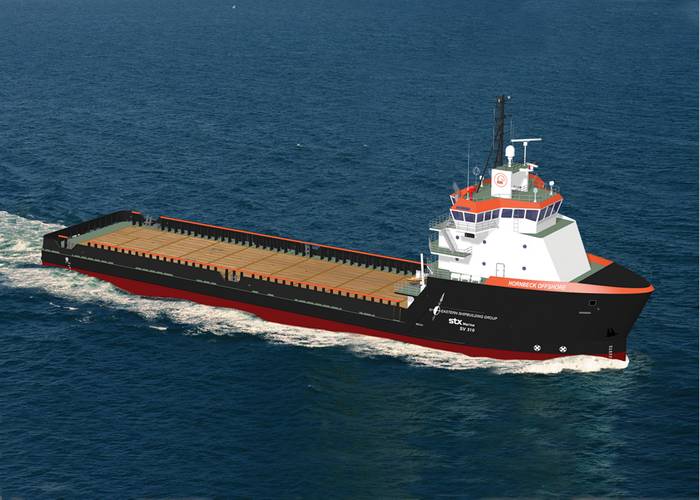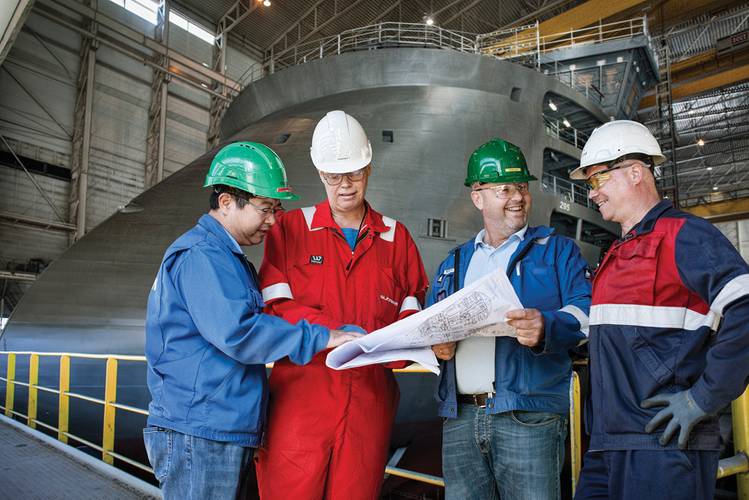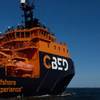OSV Tech Today
Modern Offshore Service Vessels come in a variety of shape, size and technical outfit, dependent largely on their intended area of operation. But as offshore assets are constantly mobile and global, finding work where work is to be had, there is an increasing trend towards larger, steadier platforms that are multipurpose and able to shift seamlessly from the Gulf of Mexico to the North Sea to offshore Africa, Asia or Brazil … and back again. Following here are some of the more significant OSV developments in recent months.
As necessity Is the mother of invention, the West Coast of Norway has time and again been a breeding ground for some of the world’s leading edge offshore service vessel technologies. The tip of the spear in this regard has been the Ulstein Group.
Ulstein Group, Eidesvik Offshore and Subsea 7 recently joined forces to develop a next generation Inspection, Maintenance and Repair (IMR) vessel to tackle the most demanding environments, and built to the most demanding market specifications. Long-term charterer Subsea 7, working under contract with Statoil, is now looking forward to the delivery of a truly unique vessel, the Seven Viking.
The landmark ship, an ICE-C class vessel with a crew capacity of 90, is co-owned by Eidesvik and Subsea 7 under the newly created joint concern Eidesvik Seven AS. It will operate in the harsh climate of the North Sea, carrying out a multitude of diverse tasks for Statoil, including inspection, maintenance and repair of subsea oil installations, alongside scale treatment and RFO operations.
“The specifications for this vessel were as unique as the environment it will operate in,” said Stuart Fitzgerald, VP Norway, Subsea 7. “Statoil asked us to adhere to a set of rigorous contract requirements and we, alongside our project partners at Ulstein and Eidesvik, used all our collective experience to deliver 100% on those specifications. The fruit of those labors is the ‘Seven Viking’ – a ship that is tailor-made for IMR operations and like nothing else that is on the market.”
The prototype vessel incorporates the Ulstein X-BOW design to reduce motion in transit and give increased stability in the potential five meter swells that sometimes characterize the North Sea. This is actually a compact variant on ULSTEIN’s SX148 design, measuring 106.5 x 24.5 m wide. This nimbleness, enhanced by a top speed of 16 knots, designed to allow the Seven Viking to maneuver easily in confined spaces, such as between platforms, accessing difficult to reach areas.
“It is a truly optimized design for its array of tasks,” said Fitzgerald. “The ability to carry all the necessary maintenance equipment on board the vessel ensures that it can operate continually and meet any challenge, absolutely minimizing operational downtime. In addition, it features a separate accommodation unit – positioned away from all active work areas – to ensure that the crew can rest without any disturbances. We think we have created a modern, efficient and also comfortable working environment, which, of course, helps contribute to safe operations.”
As is expected of modern offshore vessels, particularly with the high bar demand of oil majors in having zero tolerance for time lost for safety violations, the vessel offers a number of features to keep it operating safely and efficiently, said Vidar Øvstedal, Subsea 7’s Offshore Manager.
“All the best solutions were developed to ensure safe and efficient operations”, he notes with satisfaction, “including a customized module handling system (MHS) integrated in the ship’s hangar for the safe launch and retrieval of subsea modules weighing up to 70 tons.”
He continues, “Cooperation and communication are obviously essential in tough sea environments, so the design gathers all operational personnel in one area directly above the hangar, with panoramic windows in the control room giving a full overview of this key activity area.
“Also, the ship has been developed to meet the highest working environment standards. She is a comfort class COMF-V (3) vessel, with low noise and vibration levels.
“We have achieved minimal noise levels in the hangar by opting for electric winches for the ROVs, the MHS and utility equipment etc. Meanwhile, to minimise working at heights and manual handling, man-riding baskets and utility cranes will be installed in the hangar area. The vessel also has a high freeboard, which provides additional safety for the deck crew.”
Øvstedal adds that several notable environmental initiatives have been taken when designing the vessel, which also carries the Clean Design notation. These include the diesel electric propulsion, which reduces atmospheric emissions, while the ship’s electrical winches mean there will be absolutely zero emissions of hydraulic oil.
“As befitting Statoil’s requirements, which were detailed in a stringent specification, the ‘Seven Viking’ is a vessel of unmatched technical and operational capacity within this sector,” he said.
“We have been working together to find tailored solutions for the client’s demands and have come up with a next generation vessel that makes incremental steps forward in IMR ship development.
The vessel is scheduled to launch in December 2012, marking the beginning of a new Viking age on the North Sea’s most tempestuous waters.
HOS Signs HOSMAX310 OSV Options with Eastern Shipbuilding
Hornbeck Offshore Services exercised two of its 24 option, 302 x 64 x 26-ft. HOSMAX310 Offshore Support Vessels with Eastern Shipbuilding. Eastern is now under contract to construct 10 of these vessels for Hornbeck. The two additional option vessels are being built to the STX SV310 design from STX Marine. These vessels have been designated as the HOSMAX series by Hornbeck and are USCG, ABS, SOLAS, DPS-2, AC Diesel-Electric powered, twin Z-drive propelled OSVs. The vessels feature four CAT 3516C 16-cylinder turbo-charged Tier III diesel generator engines that are rated 1825 kW at 1,800 rpm. Main propulsion power is provided by two GE Energy furnished Hyundai 2500 kW 690VAC motors driving two Schottel SRP 2020 FP Z-Drives with nozzles rated at 2,500 kW at 1,025 rpm each for a total of 6,704 Hp. Schottel also provides two STT 4 fixed pitch tunnel thrusters rated at 1,180 kW at 1,170 rpm, each with direct coupled Hyundai 690VAC electric motors. GE Energy provides the complete system integrated diesel electric package, including the propulsion and thruster drives, motors, control systems, DP system, switchboards, motor control centers, automation and navigation/ communication electronics. The vessel is capable of a maximum speed of 14 knots with a cruising speed of 12 knots.
All 10 of the HOSMAX vessels under contract are USCG, SOLAS, ABS Classed A1, Offshore Support Vessel Ocean Service, Loadline, AMS, ACCU, Circle E, , with additional ABS Class notations UWILD, ENVIRO, DPS-2 and FFV-1.
The total below-deck capacities of the HOSMAX310 include 285,645 gal. of diesel fuel, 610,137 gal. of drill/ballast water, 21,509 barrels of liquid mud, 14,347 cu. ft. of dry-bulk mud, 2,212 barrels of methanol and 62,538 gals. of potable water.
STX Marine with offices in Canada and the United States provides the design based on the very successful and proven Eastern Shipbuilding “Tiger Shark Class” series. Five (5) other offshore supply vessels in this series have been delivered to Eastern’s clients; these vessels are already proven themselves in worldwide operations. The fully integrated bridge is arranged for increased visibility and features the latest technology in navigation, communication equipment.
Damen-design PSVs for Wilson Sons Ultratug Offshore
Damen Shipyards enhanced its penetration in the Brazilian offshore market with six Platform Supply Vessels (PSVs), type PSV 4500, built under license by Wilson Sons (Santos, Brazil) for Wilson Sons Ultratug Offshore (WSUT). Two vessels have been recently delivered; the other four will be delivered in 2013.
Damen and Wilson have had a business relationship for 20 years and the new vessels will be supplied to WSUT, a joint venture between Brazilian operator Wilson, Sons and the Chilean Ultratug group for long term charter to Petrobras. To date Wilson, Sons has built 16 Damen PSVs, all for their own fleet.
In Brazil local manufacturing is a key factor and the service through Damen Technical Cooperation (offering ships in kit form for completion locally) ensures the shipbuilder complies with the 60% local content threshold imposed by the government.
Wilson, Sons is the largest operator of harbour tugs in Brazil and already has a large fleet of Damen vessels comprising Azimuth Stern Drive (ASD) tugs and Platform Supply Vessels (PSV).
The 4500 dwt vessel measures 87 x 16 m with a 6.2m draft, offering a large deck area amounting to 840 sq. m. A diesel electric propulsion system comprising four Caterpillar 3512C generator sets, each of 1,570 ekW at 1,800 rpm, power two Rolls-Royce azimuth thrusters of 2,500 kW. Fixed pitch propellers of 2,800 mm diameter, with nozzle, deliver a speed of 13 knots (at 5 m draft). A Caterpillar C9 genset of 238 ekW at 1,800 rpm is for emergency use. Twin bowthrusters are outfitted to aid in maneuverability and the vessel has a dynamic positioning DP2 classification. There is accommodation for 14 crew and up to six passengers.
Currently Damen is engaged in the design of a new range of PSVs, which will cover five models, the 3300 (the number relates to the vessels’ deadweight), the smaller 1600 and 2500 and the larger 4000 and 5000, which are currently being designed. Together with Wilson, Sons, Damen is developing several other vessel types for the Brazilian offshore market, such as Anchor Handlers, ROV Support Vessels and Well-stimulation Vessels.
Bollinger Wins Six OSV Conversions from Hornbeck
Bollinger Shipyards won a contract by Hornbeck Offshore Services (HOS) to convert six 200 class DP1 offshore supply vessels (OSV’s), to 240 class DP2 OSV’s, following an announcement by HOS on September 4, 2012, saying they decided to implement a retrofit program to stretch and upgrade six 200 class DP-1 OSVs into 240 class DP-2 OSV’s. The designated vessels for the program are six of Hornbeck’s 10 Super 200 class DP1 units, four of which are the vessels that recently completed two-year charters with Petrobras in Brazil.
To meet the delivery schedule, Bollinger will carry out the conversions at two separate Bollinger facilities, Bollinger Larose and Bollinger Morgan
Brazilian OSVs to have Rolls-Royce DNA
Rolls-Royce won a $38.4 order to design and equip four platform supply vessels (PSVs) for Brazilian ship owner Bravante Group, former Navegação São Miguel Ltda. The UT 775 SE PSVs will b designed to carry deck cargo, pipes and diesel oil to and from offshore oil and gas platforms. They will be chartered by Petrobras. Bravante Group will build the vessels at their ship yard in Niteroi, Brazil, as they have done for previous orders.
In addition to the design, Rolls-Royce will supply its Azipull and bow thrusters, deck machinery, a bulk handling system, Active Front End (AFE) frequency converters, automation and control systems and a dynamic positioning system.
Grandweld Delivers 42m Crew Boats
In early October Grandweld Shipyards won a contract to build 42M Aluminum Crew Boat for Wesal Shipping, a contract which follows the delivery of the 41M Aluminum Crew Boat that Grandweld delivered to Wesal early in October 2010. The 42M Aluminum Crew Boat is a heavily modified version of the 41M, and is designed to reach a speed in excess of 25 knots and includes luxury seating, accommodation for VIP guests, larger deck space and enhanced comfort for the crew. The vessel features a total seating capacity for 83, 110 sq. m. loading area for over 90 Tons of deck cargo, in addition to the capacity of carrying large amount of fuel and freshwater.
In addition, Grandweld signed a deal in August 2012 to deliver another 42M Crew Boat for Global Marine.
Grandweld has recently opened its 55,000sqm facility at Dubai Maritime City which is expected to expand the annual capacity in terms of number of new builds. Its current orderbook includes more than 20 vessels of both steel and aluminum including: Seismic Support vessels, Anchor Handling Tug Supply Vessels with DP2 capability, Work Maintenance vessels, Fast Intervention Supply vessels (FISV), Crew Boats and many more.
(As published in the November edition of Maritime Reporter - www.marinelink.com)














